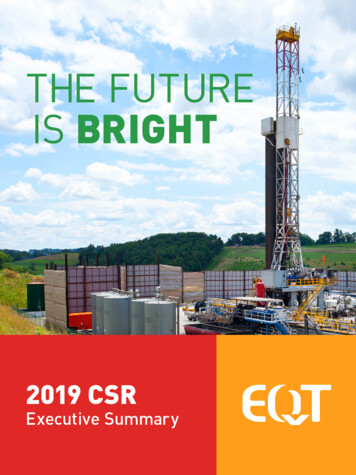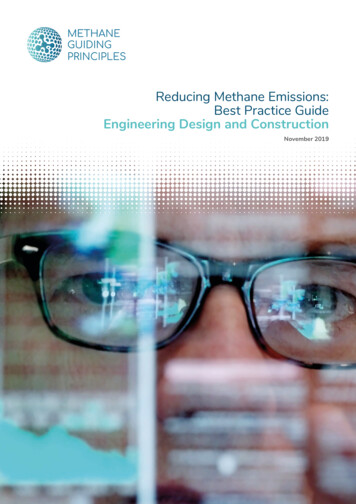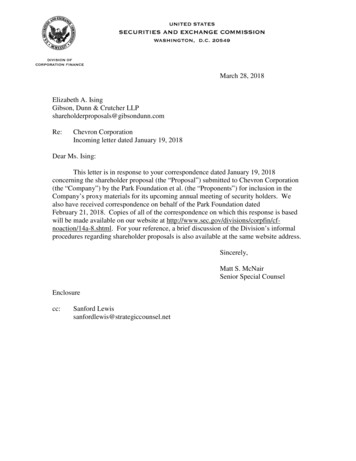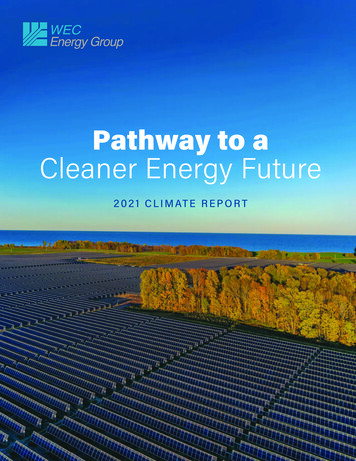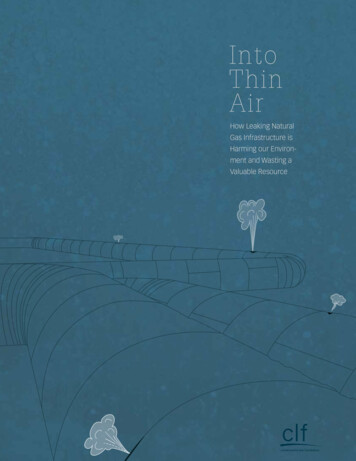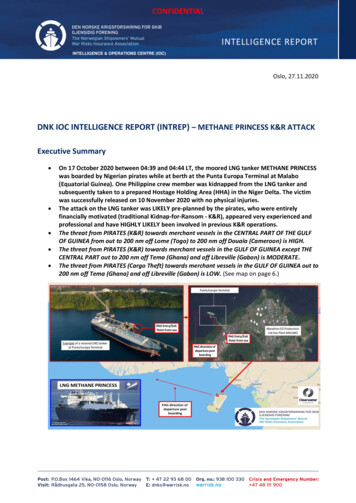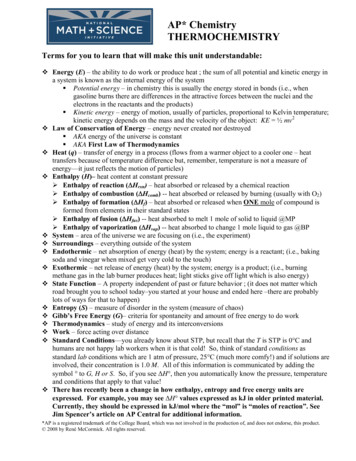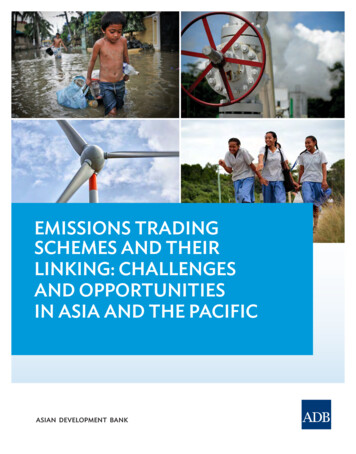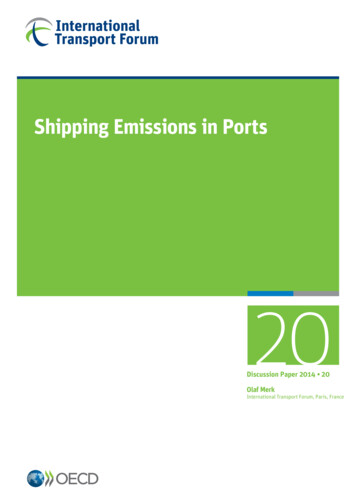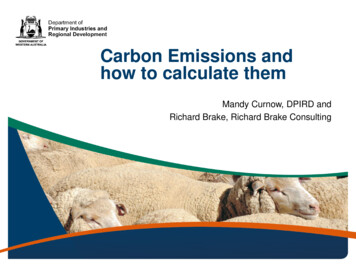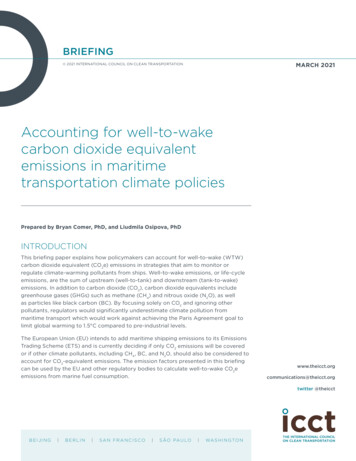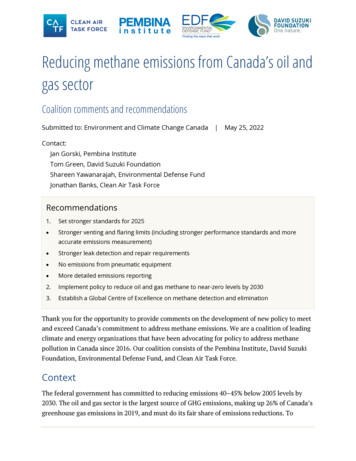
Transcription
Reducing methane emissions from Canada’s oil andgas sectorCoalition comments and recommendationsSubmitted to: Environment and Climate Change Canada May 25, 2022Contact:Jan Gorski, Pembina InstituteTom Green, David Suzuki FoundationShareen Yawanarajah, Environmental Defense FundJonathan Banks, Clean Air Task ForceRecommendations1.Set stronger standards for 2025 Stronger venting and flaring limits (including stronger performance standards and moreaccurate emissions measurement) Stronger leak detection and repair requirements No emissions from pneumatic equipment More detailed emissions reporting2.Implement policy to reduce oil and gas methane to near-zero levels by 20303.Establish a Global Centre of Excellence on methane detection and eliminationThank you for the opportunity to provide comments on the development of new policy to meetand exceed Canada’s commitment to address methane emissions. We are a coalition of leadingclimate and energy organizations that have been advocating for policy to address methanepollution in Canada since 2016. Our coalition consists of the Pembina Institute, David SuzukiFoundation, Environmental Defense Fund, and Clean Air Task Force.ContextThe federal government has committed to reducing emissions 40–45% below 2005 levels by2030. The oil and gas sector is the largest source of GHG emissions, making up 26% of Canada’sgreenhouse gas emissions in 2019, and must do its fair share of emissions reductions. To
achieve this 2030 target, short-term emissions reductions in the sector must be prioritized.Therefore, these methane regulations are critical to achieving rapid GHG reductions in the oiland gas sector, and Canada’s overall emissions goals.We commend the federal government for committing to cap greenhouse gas emissions fromCanada’s oil and gas industry. Vital to the success of this policy will be reductions in methaneemissions, and we are pleased to see the federal government showing leadership by: Committing to reduce methane emissions from the oil and gas sector by at least 75%(below 2012 levels) by 2030. Signing the Global Methane Pledge at COP26, which aims to reduce global methaneemissions 30% below 2020 levels by 2030. Committing to establish a Global Centre of Excellence for methane detection andelimination.Canada’s 2030 Emissions Reduction Plan, released March 2022, also highlights methane as thefoundation of the government’s near-term plans to reduce greenhouse gas emissions in the oiland gas sector. Addressing methane is low cost and much can be done using existingtechnologies already required in other jurisdictions. Rapidly tackling methane will be crucial toachieving milestone emission reductions during this decade, thereby making important earlyprogress towards the sector’s 2030 target and staving off serious near-term impacts ofwarming.1 Action on methane will keep Canada (and Canadian technology providers) at theforefront of global methane mitigation efforts and the innovative technology that supports thatmitigation. In this submission, we urge Canada to: Strengthen methane regulations for the oil and gas sector with new rules applicableearly in 2025 to facilitate crucial interim reductions during this decade. Adopt further measures that will achieve near-zero methane emissions in the oil andgas sector by 2030. In doing so, the government would match the level of ambition formethane emissions reduction already set out by the Oil and Gas Climate Initiative, aglobal consortium of companies representing 30% global oil and gas production.The urgency — and opportunity — of ambitious action on methaneMethane is a potent greenhouse gas with more than 80 times the climate warming impact ofcarbon dioxide; it is thus imperative to rapidly and aggressively reduce global methaneemissions, to reduce the pace and amount of global warming. As noted above, tackling methanerepresents one of few early opportunities for rapid, deep emissions reductions in the oil and gasIlissa B. Ocko et al., “Acting rapidly to deploy readily available methane mitigation measures by sector canimmediately slow global warming” Environmental Research Letters 16, no. 5 1748-9326/abf9c81Reducing methane emissions from Canada’s oil and gas sector 2
sector. While other mitigation actions will remain important to overall greenhouse gasemissions reductions in the oil and gas sector for 2030, they are not practicable to achieve therapid and deep cuts to emissions by mid-decade. Reducing methane emissions generated by oiland gas production is one of the most cost-effective and feasible measures to rapid greenhousegas reductions in the near term. Methane is one of the industry’s principal products, andmitigating emissions typically means implementing measures that essentially keep methane ‘inthe pipe’ rather than letting it escape.Addressing methane emissions in the oil and gas sector is more essential than ever. The latestIPCC Assessment Report emphasizes that, in order to keep global warming to 1.5 degrees,global greenhouse gas emissions should peak by 2025, and total economy wide methaneemissions should be reduced by a third from 2019 levels by 2030. Yet the global trend iscurrently in the wrong direction: measurements of atmospheric methane concentrations showthat both 2020 and then 2021 set records for annual increases in methane concentration.2Canada’s current standards on oil and gas sector methane emissions are not in line withestablished best practices. The United States Environmental Protection Agency (EPA) hasproposed draft regulations that will be well ahead of Canada’s regulations. Additionally, severalU.S. states already have regulations in force that go well beyond Canadian standards, and insome cases, well beyond the EPA’s proposed standards. Given the urgency of reducing methaneemissions and the importance of showing progress within the oil and gas sector towards its2030 target, Canada must move rapidly and update its regulations to align with theseestablished regulatory approaches.Canada must also move further in reducing harmful methane emissions. The Oil and GasClimate Initiative, a group of the twelve major global oil and gas companies, has pledged toachieve near-zero methane emissions by 2030.3 This should be the goal of the Canadiangovernment as well, to maintain global leadership, and ensure that its oil and gas sector canmeet its 2030 target.National Oceanic and Atmospheric Administration, “Increase in atmospheric methane set another record during2021,” news release, April 7, 2022. spheric-methane-setanother-record-during-20212Oil and Gas Climate Initiative, “OGCI members aim for zero methane emissions from oil and gas operations by2030,” March 8, 2022. nd-2030/3Reducing methane emissions from Canada’s oil and gas sector 3
Recommendations1.Set stronger standards for 2025We recommend that the federal government implement stronger regulations that come intoforce in 2025 to ensure that the oil and gas industry rapidly utilizes available, establishedtechnology and practices to reduce harmful methane pollution. In doing so, the governmentwill help to ensure interim emissions reductions take place in this decade, thereby facilitatingearly progress towards the sector’s 2030 target under the oil and gas cap.This strengthening of regulations should include: stronger venting and flaring limits backed by robust measurement, monitoring, andreporting rules standards requiring that leak detection be carried out more frequently and at allindustry sites, and using the full spectrum of technologies (i.e., ground-based oil andgas imaging, drones, towers and aerial screening) to ensure prompt detection of leaks replacement of venting, gas-driven pneumatic controllers and pumps with nonemitting alternatives.Fast implementation of these measures is appropriate because they are proven, require onlyon-the-shelf technology, and are already in place elsewhere (as detailed below).It is still likely that, under the current regulatory framework, Canada’s 2025 methane reductiontarget will not be met. Numerous studies have consistently shown that methane emissions areas much as twice as high as current estimates.4, 5, 6, 7 A recent study in British Columbiaconducted by the B.C. Methane Emissions Research Collaborative (MERC) shows that most ofthe extra emissions come from storage tanks, compressors and unlit flares, which account formore than half of all methane emissions in the sector.8 These additional sources of emissionsK. MacKay et al., “Methane emissions from upstream oil and gas production in Canada are underestimated,”Scientific Reports 11, 8041 (2021). https://doi.org/10.1038/s41598-021-87610-34M.R. Johnson, D.R. Tyner, S. Conley, S. Schwietzke, and D. Zavala-Araiza, “Comparisons of Airborne Measurementsand Inventory Estimates of Methane Emissions in the Alberta Upstream Oil and Gas Sector,” Environmental Scienceand Technology 5, no. 21 (2021). https://doi.org/10.1021/acs.est.7b035255D. Zavala-Araiza et al., “Methane emissions from oil and gas production sites in Alberta, Canada,” Elementa:Science of the Anthropocene (2018) 6:27. https://doi.org/10.1525/elementa.2846E. Chan, D.E. Worthy et al. “Eight-Year Estimates of Methane Emissions from Oil and Gas Operations in WesternCanada Are Nearly Twice Those Reported in Inventories,” Environmental Science and Technology 54, no. 23 id Tyner and Matthew Johnson. “Where the Methane Is—Insights from Novel Airborne LiDAR MeasurementsCombined with Ground Survey Data,” Environmental Science and Technology 55, no. 14 015728Reducing methane emissions from Canada’s oil and gas sector 4
are not captured in Canada’s National Inventory Report and are not effectively managed bycurrent provincial regulations.These emissions were present in the baseline year (2012). The addition of this substantial set ofemissions to the baseline inventory — coupled with the fact that these sources are noteffectively addressed by the current provincial regulations — indicates that Canada will fallshort of its 2025 target, unless changes to the regulatory framework are introduced.1.1Stronger venting and flaring limitsThe practice of venting is responsible for a significant amount of Canada’s methane emissions,and studies consistently show that vented emissions are underreported.9 One 2017 field studyin Alberta found that emissions from venting in the province could be up to 2.5 times higherthan reported.10 Mitigating emissions from venting and flaring is also especially low-cost, withcosts well below the federal carbon price (no more than 11/t CO2e).11 A 2019 study from theCanadian Energy Research Institute (CERI) shows that venting can be mitigated for less, under 5/t CO2e.A recent study in British Columbia found that 23% of methane emissions in the provinceresulted from unlit flares.12 This indicates that flares should be inspected frequently for flameouts and equipped with auto ignitors.Finally, we note that Canada is a signatory to the World Bank’s Zero Routine Flaring by 2030initiative and should align venting and flaring regulations to achieve this commitment.131.1.1 Stronger performance standardsSome North American jurisdictions have already implemented or proposed ambitious limits onventing and flaring of associated/casinghead gas and venting from storage vessels: Alberta (Peace River region): routine venting of solution gas is not allowed, nonroutine flaring is limited to 3% of total annual gas production volumes, and9MacKay, “Methane emissions from upstream oil and gas production in Canada are underestimated.”Johnson, “Comparisons of Airborne Measurements and Inventory Estimates of Methane Emissions in the AlbertaUpstream Oil and Gas Sector.”10David Tyner and Matthew Johnson. “A Techno-Economic Analysis of Methane Mitigation Potential from ReportedVenting at Oil Production Sites in Alberta,” Environmental Science and Technology 52, no. 2 Tyner, “Where the Methane Is.”World Bank, “Zero Routine Flaring by 2030.” -flaring-by203013Reducing methane emissions from Canada’s oil and gas sector 5
conservation rates at heavy oil and bitumen wells and facilities must exceed 95%.14 Forcomparison, the average conservation rate at all non-thermal operations in Alberta in2020 was only 89%.15 U.S. EPA: recently proposed the prohibition of routine venting of associated gas at allwells. Additionally, since 2011, the EPA has required that all new tanks with volatileorganic compounds (VOC) emissions in excess of 6 short tons16 per year (TPY) reducethese emissions by 95%. (EPA estimates that typically, a tank emitting 6 TPY of VOC isemitting less than 1.5 TPY of methane.) The EPA has proposed that existing storagetanks or tank batteries with a potential to emit of 20 TPY of methane must also reduceemissions by 95%. All pollution control equipment is subject to regular leak detectionand repair (LDAR) inspection requirements. Colorado: prohibits routine venting or flaring of associated gas from all wells.Additionally, all new and existing tanks with actual uncontrolled emissions of 2 TPY ofVOC (typically, about 0.5 tons of methane, according to U.S. EPA data) or greater aresubject to a 95% emissions control limit. 98% control is required when a flare is usedinstead of vapor capture. Auto igniters are also required for any flare, to prevent flameouts (where the flame goes out and the methane is vented). New Mexico: prohibits routine venting and flaring of gas from wells. In addition, allnew or modified tanks with the potential to emit 2 TPY of VOC upon start-up mustreduce emissions by 95%. Existing tanks with a potential to emit 3 TPY of VOC locatedat multi-tank batteries, as well as existing tanks with a potential to emit 4 TPY of VOCsat single tank batteries, must also reduce emissions by 95%. For all tanks, combustioncontrol devices, if used, must have a minimum design combustion efficiency of 98%.As a first step towards eliminating venting and flaring by 2030, we recommend thatCanada implement these best practices in 2025: Eliminate routine venting and flaring17 of associated/solution/casinghead gas at allwells. This will align with existing best practices in other jurisdictions including thePeace River region of Alberta (as outlined above) and conform with Canada’sinternational commitments.Alberta Energy Regulator, Directive 084: Requirements for Hydrocarbon Emission Controls and Gas Conservation in thePeace River Area (2018). ective084.pdf14Alberta Energy Regulator, Upstream Petroleum Industry Emissions Report 0B-2021.pdf151 U.S. short ton 0.907 metric ton. Since U.S. emission standards are expressed in short tons, we retain that unithere, so the terms “tons” and “tons per year” or “TPY” refer to U.S. short tons.1617Routine venting and flaring is done at a well in the absence of a gathering line or sufficient takeaway capacity.Reducing methane emissions from Canada’s oil and gas sector 6
Implement standards limiting venting from storage tanks, in line with standards forColorado and New Mexico. Design standards to require or incentivize operators to capture rather than combustmethane from tanks, unless doing so is infeasible.18 We recommend that operatorsshould capture vented emissions, and either use the captured natural gas on-site as fuelor send it to a sales line. Where feasible, this should be adopted as a primary compliancemechanism. Only where operators demonstrate that capture and on-site use or sales areinfeasible, should destruction (with flares or combustion devices) be allowed. Thebenefits of capturing gas are multifold: reduced emissions of methane and other airpollutants, reduced wasted gas resulting in additional natural gas sales (increasingrevenue for operators and royalties for governments), and alignment with Canada’scommitment to the World Bank’s Zero Routine Flaring by 2030 initiative. Specify a 98% destruction and removal efficiency (DRE) for all combustors and flares,and require auto-igniters at all flares.1.1.2 More accurate emissions measurementFor any venting sources that are not eliminated through the above regulatory changes, bettermeasurement should be required to improve the accuracy of vented amounts. The moststraightforward way to achieve this is to require operators to measure (rather than estimate)gas production and vented volumes. Current reporting protocols require infrequent testing ofthe gas-to-oil ratio (GOR) at facilities which is then used to report production estimates, withvented volumes calculated from production estimates. However, data from Albertademonstrates that gas production is highly variable.19 Accordingly, GOR measurements canvary significantly depending on when the GOR test is carried out.To address this problem, we suggest operators be required to directly measure, rather thanestimate, all vented or flared gas volumes.1.2Stronger leak detection and repair (LDAR) requirementsLeaks and other unintended emissions which arise due to upset conditions or malfunctions area significant source of methane emissions at oil and gas facilities. Numerous studies utilizingdirect measurements show that equipment leaks are unpredictable, mutable, andFor example, the California Air Resources Board requires separators and tank systems with an annual emissionrate of 10 metric tons/year of methane to control emissions from the separator and tank system and uncontrolledgauge tanks located upstream of the separator and tank system with the use of a vapor collection system (CARB: 17C.C.R. Section 95668.(a)(6),(7)).18J. R. Roscioli, et al., “Characterization of Methane Emissions from Cold Heavy Oil Production with Sands (CHOPS)Facilities,” Journal of the Air and Waste Management Association 68, no.7 609619Reducing methane emissions from Canada’s oil and gas sector 7
heterogeneous. This points to the need for frequent inspections to identify and repair leakingor malfunctioning equipment.There is evidence that these emissions are concentrated, with a small percentage of sourcesaccounting for a large portion of emissions. One study conducted in and around Red Deer,Alberta found that 20% of the oil and gas facilities measured were responsible for 74–79% oftotal methane emissions.20 This is consistent with studies conducted in different basins in theU.S.,21 and demonstrates the need for frequent leak detection and repair.22These unintended emissions are difficult to predict. Several studies have investigated therelationship between well characteristics/configurations and large unintended emissions,finding they are only weakly related.23 A 2016 helicopter study of the southwest Pennsylvaniaregion of the Marcellus Basin found that these events occur randomly and are not closelycorrelated with specific characteristics of well pads (age, production type, well count).24 Arecent survey of wells in southern Alberta noted that emissions volumes were not proportionalto levels of production, indicating that both high- and low-producing wells need to be surveyedfrequently.25One of the reasons cited for limiting LDAR requirements to three times per year is to accountfor operational difficulties in the winter months. However, LDAR data from the B.C. Oil and GasCommission shows that LDAR was conducted at oil and gas facilities in the winter.26 There donot appear to be persistent access issues in wintertime, both in Canada (Alberta’s Directive 055requires monthly visual inspections of tanks) and in other jurisdictions with challenging winterconditions like Colorado (which requires quarterly or monthly inspections depending on facilitysize) or Wyoming (which requires quarterly inspections of well sites with a potential to emit 4TPY of VOC in the Upper Green River Basin).20Zavala-Araiza “Methane emissions from oil and gas production sites in Alberta, Canada.”Harriss, et al. “Using Multi-Scale Measurements to Improve Methane Emissions Estimates from Oil and GasOperations in the Barnett Shale, Texas: Campaign Summary,” Environmental Science and Technology 49 (2015).https://doi.org/10.1021/acs.est.5b0230521D. Cusworth et al. “Intermittency of large emitters in the Permian Basin,” Environmental Science and TechnologyLetters 8, no. 7 (2021). https://doi.org/10.1021/acs.estlett.1c0017322D.R. Lyon et al., “Constructing a Spatially Resolved Methane Emission Inventory for the Barnett Shale Region,”Environmental Science and Technology, 49, no. 13 (2015). https://doi.org/10.1021/es506359c23D.R. Lyon et al., “Aerial Surveys of Elevated Hydrocarbon Emissions from Oil and Gas Production Sites,”Environmental Science and Technology 50, no. 9 (2016). https://doi.org/10.1021/acs.est.6b0070524Arvind P Ravikumar et al. “Repeated leak detection and repair surveys reduce methane emissions over scale ofyears” Environ. Res. Lett. 15 034029 (2020)25B.C. Oil and Gas Commission, “Leak, Detection and Repair Data for Wells and Facilities /data-centre/?category 277226Reducing methane emissions from Canada’s oil and gas sector 8
A recent study in British Columbia found that 23% of methane emissions in the provinceresulted from unlit flares.27 This indicates that flares should be inspected frequently for flameouts and equipped with auto ignitors.1.2.1 Comprehensive and frequent LDARRegular inspections with modern detection instruments — such as optical gas imaging (OGI)cameras — is the best way to minimize emissions from these sources. Recognizing this, manyjurisdictions now require frequent LDAR inspections at most or all sites: Alberta (Peace River region): operators are required to conduct monthly LDARsurveys at high-risk sources which include storage tanks, flare ignitors/pilots, andcompressor seals, and must quantify all leaks that are not repaired within 24 hours.28 Colorado: requires existing sites to be surveyed at various frequencies, but all new sitesare inspected monthly. California: requires quarterly inspections of all well sites, gathering and boostingcompressor stations, and transmission compressor stations. New Mexico: requires regular inspections for all well sites, including quarterlyinspections for all well sites with calculated potential annual emissions of 5 TPY ofVOCs or more. Compressor stations with potential VOC emissions of 25 TPY or moremust also conduct quarterly inspections. U.S. EPA: has proposed quarterly inspections for well sites with estimated annualemissions of 3 TPY or more of methane.Due to the unpredictability and mutable nature of equipment leaks, we recommend thatLDAR inspections should conducted at least quarterly at most facilities, and monthly atlarger facilities (an increase from three times annually in the federal regulation).1.2.2 Shift towards measurement-based LDARWe recommend facilitating the implementation of emerging technologies for LDAR, includingtechnologies that would allow inspection of many facilities over a wide area (for example fromaircraft) by an independent party. It is essential that any such approach be strictlymeasurement-based, and sensitive enough to find small emissions sources. Natural ResourcesCanada’s (NRCan) Centre for Excellence could help develop standards for measurement-basedLDAR.The federal government should also consider moving towards an independent, centralized, andnational measurement-based LDAR program. This program could be housed in an arm’s-length27Tyner, “Where the Methane Is.”28Directive 084.Reducing methane emissions from Canada’s oil and gas sector 9
organization such as an academic institution to ensure independence. Data from this programcould fulfill the need for government and regulators to conduct regular inspections to ensureindustry is compliant. Industry could also have an option to pay into the program and use it toconduct LDAR. This approach is efficient as it combines regulatory LDAR and compliancemeasures. It also addresses inequality concerns by making measurement-based LDAR moreaccessible to small companies that have fewer resources to manage and run LDAR programsand explore alternative technologies. A centralized program would also decrease costs of LDARacross the sector through economies of scale and could provide centralized LDAR data to manystakeholders including industry, regulators, governments, researchers, and the public.The NRCan Centre for Excellence on methane could be used as a foundation for such aprogram, if there is a focus on emissions detection and measurement in the oil and gas sector.Such a program, funded by industry, would streamline data-gathering, verification, andcompliance, as well as fulfill the Centre’s mandate to improve methane detection andelimination.1.3No emissions from pneumatic equipmentPneumatic controllers and pneumatic pumps are a significant source of methane pollution.Recent field studies in Alberta indicate that pneumatic controllers and pumps are responsiblefor about 20% of methane emissions.29There are a number of approaches that could eliminate, or essentially eliminate, methane andother emissions venting from pneumatic controllers. A 2016 study shows that cost-effectivezero-bleed options exist for both new and existing pneumatic devices, even where grid power isnot being used at the site; these options have been proven to work robustly in upstream oil andgas operations in Canada and more broadly in North America.30 A recent update to this reportfinds that new technologies have appeared on the market since 2016, while implementationbarriers have lowered for some of the more established technologies that were described in the2016 report. The update finds that “zero-emission controllers are very relevant for reducingemissions from the oil and gas sector.”31A number of Canadian and U.S. jurisdictions have standards in place requiring zero-bleedpneumatic devices and pumps at new and existing facilities. Similarly, U.S. EPA has proposed29Tyner, “Where the Methane Is.”Carbon Limits, Zero Emission Technologies for Pneumatic Controllers in the USA: Applicability and cost effectiveness(2016), 3-4. ogies-for-pneumatic-controllers-usa/30Carbon Limits, Zero Emission Technologies for Pneumatic Controllers in the USA: Updated applicability and costeffectiveness (2021), ii. ng methane emissions from Canada’s oil and gas sector 10
standards that would require non-emitting controllers at all new and existing well sites andcompressor stations in the U.S.: British Columbia: requires all new pneumatic controllers and pumps to be zero bleed,and required retrofit of existing controllers at all large compressor stations to eliminateemissions by the beginning of 2022. Colorado: has prohibited the use of venting gas-driven controllers at new sites sinceMay 2021, and also requires operators to retrofit a portion of their fleet of venting gasdriven controllers to eliminate emissions. Operators were required to convert a certainportion of their facilities or controllers by May of this year, and must completeadditional conversion by May 2023. New Mexico: has very recently promulgated rules which will prohibit the use of ventinggas-driven controllers, and will also require operators to phase out existing gas-drivencontrollers over a period of several years.Numerous technologies are available for retrofitting sites to eliminate venting controllers. TwoCanadian examples are Westgen Technologies’ EPOD and Calscan’s Bear solar-ready electricactuators and fail-safe power and controller systems.32 Technologies like this allow replacementof venting gas-driven controllers at all sites, including small off-grid locations, making itfeasible to eliminate the use of wasteful, polluting venting controllers.We recommend that ECCC require all new and existing pneumatic devices and pumps tobe zero-bleed starting in 2025.1.4More detailed emissions reportingTo ensure transparency and evaluate compliance, regulations need to be underpinned by acomprehensive reporting framework. Federal regulations do not currently require any reportingof methane emissions, only record keeping.The U.S. EPA requires comprehensive annual reporting of methane emissions from applicablefacilities at a detailed source level in the Greenhouse Gas Reporting Program (GHGRP). Anotherexample is B.C., which requires detailed reporting and quantification of all leaks by sourceWe recommend that Canada adopt detailed source-level reporting similar to GHGRP, and thatthe data be made publicly available to give stakeholders confidence that rules are beingfollowed. A further advantage of eliminating some sources of emissions, such as venting or32Westgen Technologies, “EPOD AP Series.” https://westgentech.com/epod-lineup/Calscan Solutions, “Bear Electric Actuators.” http://www.calscan.net/products bearfamily.html#bear actuatorsCalscan Solutions, “Bear Fail Safe System.” http://www.calscan.net/solutions BearFailSafe.htmlReducing methane emissions from Canada’s oil and gas sector 11
flaring, is that this will reduce the number of sources that operators would need to report. Thefollowing sources should be included in this reporting framework: LeaksAtmospheric storage tanks (solution/associated gas)Pneumatic devicesPneumatic pumpsReciprocating compressors packing ventsCentrifugal compressor seal ventsCasing gas vents (solution/associated gas)Well completions a
IPCC Assessment Report emphasizes that, in order to keep global warming to 1.5 degrees, global greenhouse gas emissions should peak by 2025, and total economy wide methane emissions should be reduced by a third from 2019 levels by 2030. Yet the global trend is currently in the wrong direction: measurements of atmospheric methane concentrations show
